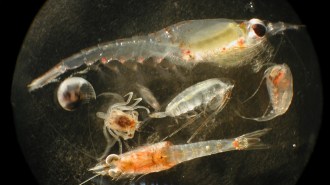A popular tree grows twice as well in the New York metropolitan sprawl as in rural New York State, according to a new test.

Clones of an Eastern cottonwood (Populus deltoides) in the Bronx and other city spots grew to double the biomass of clones planted outside small towns upstate or on Long Island, says Jillian Gregg, now of the Environmental Protection Agency’s western-ecology division in Corvallis, Ore.
The growth gap comes from ozone damage, she and her New York colleagues report. Ozone chemists have known that concentrations may spike skyscraper high in city air, but during a full 24 hours, rural trees actually get a higher cumulative ozone exposure from urban pollution that blows in and lingers. A series of new experiments now shows that this hang-around ozone is the overwhelming factor in tree growth, the researchers say in the July 10 Nature.
“This study has profound importance in showing us most vividly that rural areas pay the price for [urban] pollution,” says Stephen P. Long of the University of Illinois at Urbana-Champaign. “This work should be a wake-up call,” he adds.
Earlier studies had fingered car fumes, heavy metals in soils, and other cityscape menaces to plant life. Yet some urban quirks, such as extra warmth and increased concentrations of carbon dioxide, may boost plant growth.
To see the net effect of these opposing factors, Gregg and her colleagues planted genetically identical cottonwood saplings in farmland outside the small towns of Millbrook, Riverhead, and Upton and in four metropolitan sites. The study is “definitely the first of its kind in considering multiple factors,” she says.
For 3 years, the team set out trees in July and harvested them in September. In similar light conditions, the city trees grew faster than the rural ones. Rainfall didn’t differ significantly, nor did pest damage.
The boost didn’t come from the soil, she concluded. City trees consistently outpaced country trees, even when both were grown in soil that she had brought from the other location. Experiments in growth chambers showed that the benefit didn’t come from carbon dioxide or temperature differences.
Since she couldn’t explain how the city accelerates tree growth, Gregg says, she searched for plant inhibitors in the country. Of the 18 pollutants she checked, ozone was the only one significantly higher at her rural sites, 28 parts per billion versus 16 ppb in town. That rural dose is typical in the Northeast, she says. When she compared cottonwood growth in open-topped chambers supplied with flows of ozone at a test facility, she found big differences in growth from different ozone abundances.
“We all think of urban areas, with high automobile densities, as sites of great pollution,” says Eva Pell of Pennsylvania State University in State College. However, she points out, ozone is famously reactive, and the abundance of other urban pollutants, including nitric oxide, may scrub ozone out of city air.
“That doesn’t mean city air is cleaner. It just means it has less ozone–and that’s an important distinction,” says David Grantz, an air-quality specialist at the University of California’s Kearney Agricultural Center in Parlier.
Cottonwood trees may not suffer much from other pollutants such as particulates. However, Grantz says, a “hot area of research” now shows that people certainly do.
****************
If you have a comment on this article that you would like considered for publication in Science News, send it to editors@sciencenews.org. Please include your name and location.







